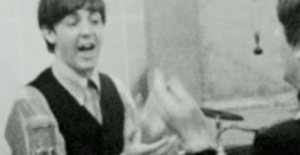Ron Howard is a master cinematic storyteller, for sure, but not someone with much interest in complexity or ambiguity. Which can be good for storytelling, but for me usually comes up wanting. I like the messy, the complicated, the things that make you say oh.
 I was curious about this picture, but would have let it slide, or ride, but friends invited me and my daughter wanted to go. So we went to Greenwich Village for some fine wood-fired brick oven Neapolitan pizza and Ron Howard’s joint, plus the promise of the whole Beatles at Shea Stadium film, remastered visually and auditorily using all the modern tricks.
I was curious about this picture, but would have let it slide, or ride, but friends invited me and my daughter wanted to go. So we went to Greenwich Village for some fine wood-fired brick oven Neapolitan pizza and Ron Howard’s joint, plus the promise of the whole Beatles at Shea Stadium film, remastered visually and auditorily using all the modern tricks.
The movie is a gas. The camera is up close on the Beatles and their fans through the 28 Days Later rush of Beatlemania, during the charge of concerts around the globe, and headlong up to the show at Shea Stadium. These guys, when they were young, ambitious and full of energy, were terrific cutups. And then it stays up close through the despair that followed the exhaustion that came after, when cutups transformed into turnoffs.
As I had expected, I felt as if I’d seen most of this footage before, but all of it was delightful, looked fantastic, and there are some revelations (for me anyway):
Early footage of some English shows in 1963 are fantastic and transforming. This wasn’t just a group of clever songwriters and melody makers, with winning personalities, but a hard rocking band. Ringo pounds on his kit, and the Beatles deliver with equal and transformative energy. Great songs, but also tight and terrific arrangements and wickedly and aggressively good playing.
McCartney, mostly, and Lennon, too, from old interviews, talk about their songwriting, and the need to hew to a schedule to put out a new single every three months, and an album every six months. The studio footage and tales, plus the clips from all the live shows they’re doing, and movies they’re making, really dial up the grueling nature of it all.
At one point Lennon talks about how silly the lyrics are in those early albums, really just placeholders while they worked on the music. Which seems like a throwaway, since so many are so clever and perfect to the form, until, later, he and McCartney talk about the personal content that John weaves into the lyrics of Help!, a song that to me has always seemed a novelty tied to the movie of the same name. But of course not!
I always forget what a cutup George was, even when I consider the hilarity of his film producing career. I mean, Withnail and I? This movie confirms he’s funny and serious, too.
I assume there will be a follow up, a sequel. Maybe Blue Jay Way: The Studio Years, but more likely Strawberry Fields Forever: The Studio Years, which will go further into the making of the last five elpees. That will no doubt be an equal treat. But the takeaway here is that the Beatles were really great, in a way that has no match, and we would be fools to forget about even a part of that greatness.
Ron Howard’s movie is a crowd pleaser, and lives up to that not modest ambition. Go and enjoy.
